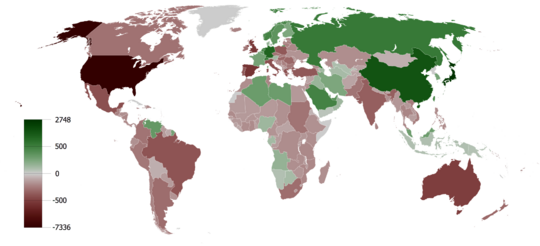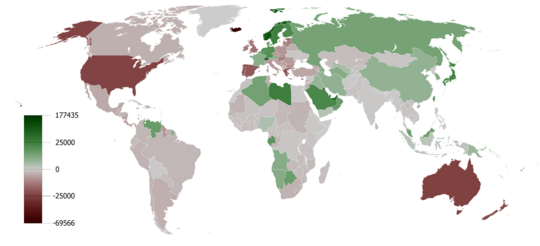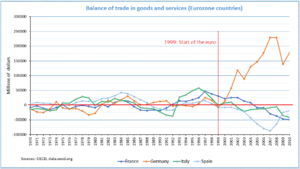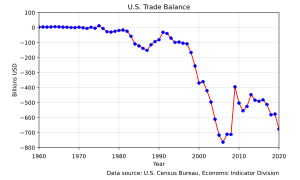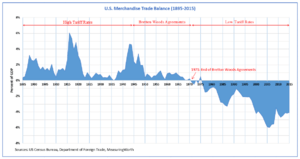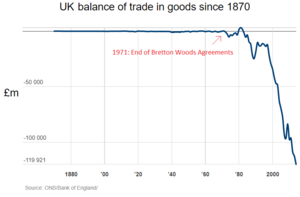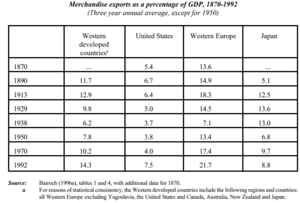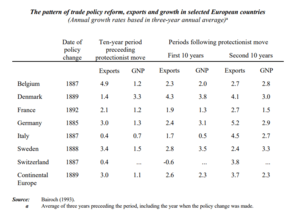Balance of trade facts for kids
The balance of trade is the difference between how much a country sells to other countries (its exports) and how much it buys from them (its imports). This is measured over a certain time, like a year. It's also called net exports.
If a country sells more than it buys, it has a trade surplus. This means it has a "positive trade balance." If a country buys more than it sells, it has a trade deficit. This means it has a "negative trade balance." In 2016, about 60 out of 200 countries had a trade surplus.
Contents
What is the Balance of Trade?
The balance of trade is part of a bigger picture called the current account. The current account also includes things like money earned from investments abroad or international aid. If a country's current account has a surplus, it means the country's total wealth from abroad is growing. A deficit means this wealth is shrinking.
The trade balance also shows the difference between what a country produces and what its people and businesses buy. This includes goods made at home and goods bought from other countries.
Sometimes, it's hard to measure the balance of trade perfectly. When all countries' export and import data are added up, exports seem to be slightly higher than imports. This shouldn't happen, because every export from one country is an import for another. This small difference might be due to things like smuggling or hidden transactions.
Many things can affect a country's balance of trade:
- The cost of making goods in one country compared to another. This includes costs like land, workers, and taxes.
- How much raw materials and other parts cost and if they are easy to get.
- Changes in how much a country's money is worth compared to other currencies.
- Taxes or rules on trade between countries.
- Rules that are not about taxes, like environmental or safety standards.
- Whether a country has enough foreign money to pay for imports.
- The prices of goods made inside the country.
The trade balance can also change during different parts of the business cycle. For example, if a country's economy grows because it exports a lot (like oil), its trade balance will lean towards exports. But if growth is driven by people buying a lot at home, the trade balance might lean towards imports.
Examples of Trade Balance
History of Trade Balance Ideas
In early modern Europe, many countries followed a policy called mercantilism. This idea suggested that a trade surplus was always good for a country. Mercantilists believed that countries should export natural resources from their colonies and then sell finished goods back to them.
An old saying from 1549 explained this idea: "We must always take heed that we buy no more from strangers than we sell them, for so should we impoverish ourselves and enrich them."
Since the mid-1980s, the United States has often bought more goods than it sold, especially from Asian countries like China and Japan. These countries now hold a lot of US debt, which helped pay for the goods the US bought. On the other hand, the US sells more to countries like Australia than it buys from them.
Countries that save a lot of money, like Japan and Germany, often have trade surpluses. China, which has grown very fast, also tends to have trade surpluses. Countries with lower savings rates, like the US, often have high trade deficits.
Some people say that China uses a mercantilist approach to its economy. Russia, for example, uses a policy called protectionism. This means they see international trade as a "win-lose" game, where one country gets richer at the expense of another.
Armenia's Trade Balance Example
For the last 20 years, Armenia has usually had a negative trade balance (a deficit). In October 2021, its trade deficit was 273.5 million US dollars. This was partly due to a war in 2020. Armenia's trade is limited because it is a landlocked country and has border issues with Turkey and Azerbaijan. This often leads to large trade deficits.
Different Views on Trade Balance
Most trade experts and economists agree that having a trade deficit isn't always a bad thing.
The International Monetary Fund (IMF) says that large trade deficits can sometimes cause problems, like a shortage of foreign money. However, some economists, like Joseph Stiglitz, argue that countries with big trade surpluses can actually harm global prosperity more than countries with deficits. They say these surplus countries take demand away from other nations.
Ben Bernanke also believes that big differences in trade within areas like the Eurozone are unhealthy. He says that when Germany sells much more than it buys, it reduces demand, jobs, and production in other countries.
For the United States, some experts like Carla Norrlöf point out three benefits of trade deficits:
- Americans can consume more goods than they produce.
- US companies can use foreign-made parts that are produced more cheaply, which helps them be more productive.
- Because the US is such a big market, other countries rely on selling their goods there. This gives the US more power in trade talks.
A study in 2018 looked at 151 countries over many years. It found that putting extra taxes on imports (called tariffs) did not have much effect on a country's trade balance.
Old Economic Ideas
Adam Smith's View
Adam Smith, a famous economist, thought that the idea of the balance of trade was "absurd." He believed that if two countries trade, neither one loses or gains if the trade is "even." But if one country sells more than it buys, the old idea was that one country loses and the other gains. Smith disagreed with this.
He wrote in 1776 that it was unnecessary to put special limits on goods from countries with whom trade was thought to be "disadvantageous." He believed that trade naturally balances itself out over time.
Keynesian Theory
John Maynard Keynes, another very important economist, spent his later years thinking about international trade balance. He helped create the Bretton Woods system after World War II. This system aimed to manage international money.
Keynes suggested a global bank that would create its own money, called "bancor." This money would be used to measure how much a country was in surplus or deficit. He believed that countries with surpluses should have a strong reason to spend their extra money. This would help clear the deficits of other countries.
Keynes thought that countries with surpluses were just as responsible for trade imbalances as countries with deficits. He warned that if trade wasn't balanced, it could lead to global economic problems. His ideas were influenced by the Great Depression, when too much international lending led to problems.
After World War II, many economics textbooks focused on the importance of trade balance. However, after the Bretton Woods system ended in 1971, these ideas became less popular. But they have gained some attention again since the financial crisis of 2007–08.
Monetarist Theory
Before the 20th century, economist Frédéric Bastiat suggested that trade deficits were actually a sign of profit, not a loss. He gave an example of a Frenchman selling wine to England and buying coal. If the wine sold for more in England than it cost in France, and the coal bought with that money was worth even more in France, the Frenchman made a profit. But the customs office would record this as a trade deficit for France. Bastiat argued that a growing economy would naturally lead to larger trade deficits.
In the 1980s, Milton Friedman, a Nobel Prize winner, also argued that trade deficits are not necessarily bad. He said that if a country exports a lot, its money becomes more valuable. This makes its exports more expensive and imports cheaper, which naturally helps balance trade.
Since 1971, the US has had large trade deficits. Friedman explained that these deficits are balanced by foreign investment coming into the US. This means that foreign countries are investing their money in the US, which helps cover the cost of the goods the US imports.
Friedman even said that the "worst-case scenario" – where a country sells goods and the foreign money it earns never returns – is actually the best outcome. It would be like the exporting country bought goods for free, by simply exchanging them for paper money that was never used again.
This idea is similar to what David Hume said in the 18th century. Hume argued that a country couldn't keep gaining from exports forever. If it hoarded too much gold (money), prices in that country would rise. This would make its goods less attractive to other countries and foreign goods more attractive to buy. So, trade balances would naturally even out.
Trade Balance and a Nation's GDP
A country's Gross Domestic Product (GDP) is the total value of all goods and services produced in that country. Exports directly increase a nation's trade balance, and imports directly reduce it.
When a country has a trade surplus, it adds to its GDP. When it has a trade deficit, it "drags" down its GDP. However, it's important to remember that foreign-made goods sold within a country still contribute to the country's total GDP through retail sales and other activities.
Trade Balance vs. Balance of Payments
| Balance of Trade | Balance of Payments |
|---|---|
| This only includes visible goods that are bought and sold, like cars or clothes. The difference between exports and imports is the balance of trade. If imports are more than exports, it's sometimes called an "unfavorable" balance. If exports are more, it's "favorable." | This includes all visible goods and invisible services (like tourism or banking) that are bought and sold. It also includes money from investments. |
| This only shows money earned or paid for buying and selling goods. It only includes income items. | This includes all income and investment items, whether they are visible goods or invisible services. The balance of trade is just one part of the bigger balance of payments. |
See also
 In Spanish: Balanza comercial para niños
In Spanish: Balanza comercial para niños
- List of countries by net exports
- Dutch disease


